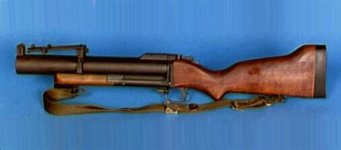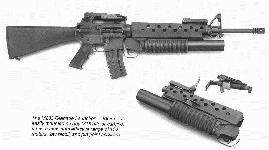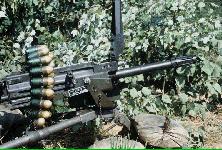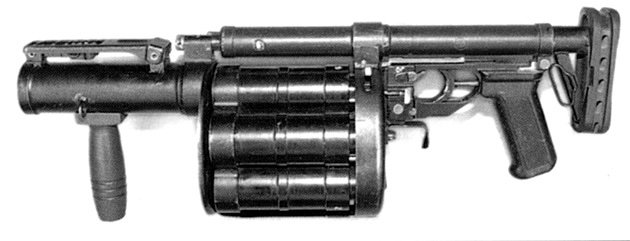The single-shot M79 40mm grenade launcher was popular in Vietnam. It was discontinued in favor of a grenade launching attachment on the M-16, called the M203. This combination has advantages, but the M203 is awkward to aim and its range is limited to 150 meters with direct fire, and 400 meters indirect. At the SEAL Team Raid on Punta Paitilla Airport in Panama, its inadequacies were revealed resulting in 4 dead and 8 wounded. The M203 is difficult to reload from the prone position, and so many gunners prefer to just fire their M-16s after the first round.


The single shot M79 used in Vietnam, now replaced by the M203
The U.S. military has also adopted the MK-19 40mm heavy machine gun, which fires the same rounds over 2000 meters. However, infantrymen need something between the M203 toy and the big MK-19; a 40mm automatic shotgun. It should be simple to enlarge a 12-gauge automatic shotgun design to accommodate 40mm rounds. The Mossberg semi-automatic "Jungle Gun" was developed for the U.S. military counter-drug operations. Why not enlarge this proven system to fire 40mm rounds? A heavier and longer barrel could triple its range over the M203. The Marine Corps tested the EX-41 a few years ago, a four-shot 40mm pump action gun which can fire rounds 1500 meters, but this revolutionary weapon was ignored.
The longer range and automatic grenade fire have obvious advantages. Since the gunner would not have to lower the weapon to reload each time, he could easily adjust his fire until he scores a direct hit. The longer range also allows smoke rounds to mark targets for Close-Air Supporting CAS), eliminating the coordination required for mortar target marking.
In March 2001, FN Herstal unveiled a revolutionary aiming device for its F2000 three-shot 40mm automatic grenade attachment. To engage a target, the shooter simply aims the integrated laser sight at the target, and the range to the target is automatically locked into the weapon's fire-control system. The shooter then elevates the weapon in the direction of the target and, when the weapon is at the correct firing angle, a pair of green lights appear on the exterior of the sight. With the weapon now a the proper super elevation to engage the target, the weapon is ready for firing. During tests, Belgian soldiers were able to consistently place rounds within two meters of targets 300 meters away.


Mossberg semi-automatic "Jungle Gun" and MK-19 40mm machine gun
This 40mm "shotgun" would become the preferred infantry weapon in close combat often found in urban, forested, and jungle environments. Firing four consecutive 40mm canister/shotgun rounds could blast the enemy during an ambush, making it a favorite for movie producers. A rifle platoon may have a dozen of these weapons, allowing it to mass indirect fires when needed. In addition, regular 40mm grenades could be fired into windows or onto rooftop during urban operations.
A 40mm automatic would be an ideal close-in anti-armor weapon by using M430 40mm HEDP "shaped charge" rounds, which can penetrate armor up to two inches thick. Light armored vehicles would become heavy coffins. These rounds could also blow tracks off of tanks and punch holes in thin rear armor. They could penetrate thin overhead armor if the gunner can position himself for a downward shot, or manages to "walk" his rounds onto a tank with indirect fire. These rounds could also blast open doors, which is always a problem in urban fighting. A simple 40mm automatic shotgun would revolutionize infantry tactics.
Carlton Meyer editorG2mil@Gmail.com
Letters
This is a great idea, but a rotary barrel system seems to work better. The Russians already developed a six-barrel 40mm grenade launcher called the RG-6 in 1993. This only has a range of 400 meters, but a longer barrel could extend range.

Many years ago I read Ralph Zumbro's rightly acclaimed book "Tank Sergeant". One thing that interested me was several references to a "three-shot grenade launcher". I assumed that this was some kind of field improvisation, but how you could join several M-79s or M-203s together without the result being unwieldy escaped me. Recently I've been lucky enough to talk to Mr Zumbro, and one of the first things I asked him about was this weapon:-
"One of our drivers in RVN had one. It had a three-shot Harmonica type magazine that slid back and forth through a fixed, slotted breech and was moved by a scroll spring. You could load any two chambers while keeping one in firing position. HELLUVAWEAPON, that's probably why they only made just a trial batch. My buddy got one off a dead infantryman. Ralph"
When I heard about this it occurred to me that such a configuration could be used as an underbarrel weapon-in fact it might be easier to reload from a prone position than the current M203. Mr. Zumbro has expanded this idea further by suggesting that the underbarrel weapon have a three shot cylinder. This would be turned manually, so the Grenadier can "dial-up" the most suitable round loaded. Each cylinder would have a switch on its side that operates a simple ejector. The capability to quickly select different types of ammunition may also have police applications.
Phil West phil.west@angelfire.com
A South African 40mm rotary gun
Have a look on this website: www.milkor.co.za/products/mglmain.htm
Arno